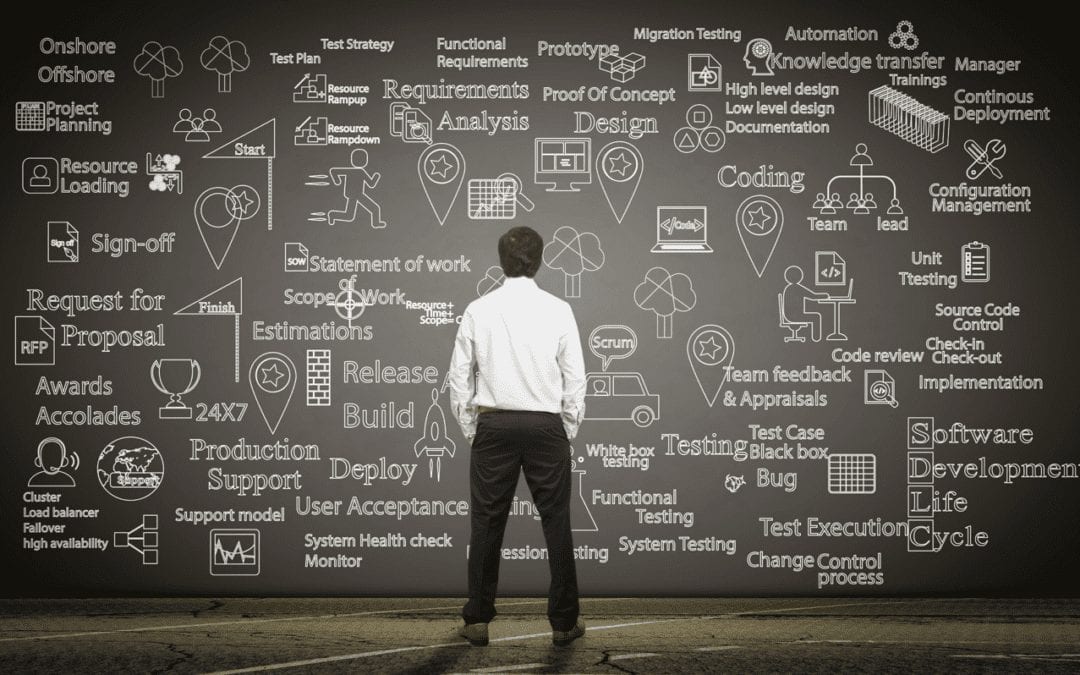EXPERIENCE ENCANVAS IN 60-MINUTES!
We're always happy to walk you through Encanvas no matter where you are in the world.

We live in a data driven business world. How do you tap into yours?
It’s thought Jeff Bezos was the first person to use the term Innovation Value Management (IVM) to describe data as a business asset based on its contributory value. If it wasn’t Jeff, then it was probably one of his team. Amazon is passionate about the value of its data. The company leadership team knows that capturing rich insights on its customers—their buying preferences and behaviors—offers an unrivalled competitive advantage.
When organizations shape their management approach to use data every day to make decisions, they are often described as operating a data driven culture. Organizations want to maximize the value of their data by using it to make business decisions. It’s never been more possible thanks to cloud computing and big data. And yet, the secret of driving business success through data often has more to do with the attitudes and skills of your people, than the technology they use.

Businesses that transition decision making to be evidence based, need curious minds to power change. Individuals at all levels of the enterprise must as the question ‘Why’ more often, and have data and analytical tooling at their disposal that equips them to rapidly find answers to those questions. In the digital age, a spreadsheet doesn’t quite cut it. You will need data harvesting and visualisation tools. More over, you will need data to be organized correctly in the first place, and probably cleansed of impurities. This is where low-code software apps come in.
Many of the new executive roles are analytics based. For example, in the office equipment industry, the transition to data-driven business has led many vendors to appoint Service Managers with an analytical background where previously, these roles were fulfilled by ‘the best field service engineers.’ Such roles today are largely about understanding patterns in data, managing people, and acting on escalations.
The latest research from Gartner suggests that, by 2023, data literacy will become an explicit and necessary driver of business value, demonstrated by its formal inclusion in over 80% of data and analytics strategies and change management programs.

Data has become the lifeblood of enterprise. Executive management teams are taking more of an active ownership role in BI initiatives than ever before. Once the bastion of large corporations—because they were the only community of business able to afford the extremely high price tag—business intelligence has become democratized over the last decade thanks to affordable ‘pay-as-you-use’ applications and cloud-based technologies that scale accessibility and affordability to dashboarding and data warehousing tools. What low-code software apps do is fulfil the ambition that many executives to further democratize business intelligence to every stakeholder in the enterprise, and potentially beyond it.
Creating a data driven ‘curious’ culture will help your business to understand customer behavior, react to market changes faster than your rivals and eliminate the unknowns. What organization would not want these abilities?

Armed with a new set of ambitions, organizations are establishing leadership roles to drive the transition of people, process, technology and data to evolve a data driven culture. The Chief Data Officer (CDO) role is growing in popularity as a standard bearer. According to the latest research from Gartner, this role is intended to:
In a digital era, businesses operate on data. Much of their opportunity is programmed into inbound marketing schemas and their operational performance depends on data analytics to execute hundreds of decisions based on fact—not gut-feel—to fine-tune internal processes and minimize sales costs. To create a data driven culture requires a culture change in many management teams that are accustomed to driving their business based on ‘hunches’ and ‘best guesses’ over what customers value and what they want. A digital economy means that enterprises no longer need to guess.
Jeff Bezos, the founder of Amazon is quoted as saying, “If you don’t understand the details of your business you are going to fail.”
The most commonly reported barriers to a data driven culture are:

The transition from analog to digital business behaviors has been swift; a matter of a few years. Many enterprises find themselves on the wrong side of this wave, operating without good customer, product, business or market insights. They find their operations somewhat sluggish compared to the ‘SaaSy’ new-kids on the block. Executives know, curious minds are needed to fast-track change at every level of the organization.
Attitudes to data vary across businesses. Leaders generally see it as crucial and an opportunity, while many departmental leaders find it a tantalizing prospect that’s probably out of reach. IT leaders, on the other hand, see data as a problem and a risk. And there will be many that see the surfacing of operational data as a risk, given that it might expose their underperformance. Bringing everyone on the same page will not be easy, but it is necessary to remain competitive in a digital economy.
Creating a data driven culture is a change project like any other. To be successful, your business needs to be armed with the same state-of-the-art methods and tools that your competitors will be using. Nothing less will do. That means harnessing robotics and artificial intelligence, analytical visualization tools, predictive modeling and automated escalation routines.
Unfortunately, when considered in isolation, none of this technology will actually help your business to harvest its opportunity and grow. Like most changes in business, it will take a blend of ‘people, process, data and technology’ to become a successful data-driven enterprise—and the need to change attitudes and behaviors will as always take center-stage.

Ian Tomlin is a management consultant and strategist specializing in helping organizational leadership teams to grow by telling their story, designing and orchestrating their business models, and making conversation with customers and communities. He serves on the management team of Encanvas and works as a virtual CMO and board adviser for tech companies in Europe, America and Canada. He can be contacted via his LinkedIn profile or follow him on Twitter.
Now read:

Without data, you’re just another person with an opinion
W. Edwards Deming, American Statistician
Data matters and it’s central to digital transformation. The problem is no matter how much companies invest in their data, and however they capture it, the quality will always be suspect. Without data, any ideas of digital transformation are likely to be a pipe dream. Low-code is transforming the ability of organizations to create custom apps to cleanse, organize and use their data.
Most companies hoard gigabytes of data on their finances, their products, their customers and markets. The difficulty is that almost no enterprise has its data organized in a structure that makes it easy to access. As soon as business leaders come up with ideas for business model re-invention, probably the next thought in the minds of DevOps leaders is ‘Where is the data coming from?’
Digital transformation projects have a habit of either generating new data (as in the case of sensor network-centric projects) or re-using old data (such as plotting assets or customers on a map and gaining value from location-centric perspectives), or a blend of the two. Re-using data found within the enterprise can be challenging because of data quality issues, the variations of data structures and field formats between applications, and issues getting data out of systems. This means DevOps teams need to have very good data management skills. Low-code platforms offer a smart new way for these teams to harness data that is close by but remains out of reach
How should DevOps teams approach their data challenges? Here are 10 ways DevOps teams are using Encanvas to breathe new life into their old data.
Old data may be held in various applications and formats. It’s not uncommon for Encanvas to gather information from spreadsheets, big back-office systems databases like SAP R3, IBM DB2, Microsoft Dynamics and SQL – all at the same time. Encanvas is a plug-and-play multi-threaded and multi-sourcing platform which means designers can create concurrent live data feeds from multiple systems or end-points at the same time. This capability is used extensively by designers when creating applications that re-use data from existing and new systems together, creating new data structures on the fly for the specific canvases they author as part of applications under development.
Your old data may require filtering to select only the records relevant to your project. A powerful feature built into Encanvas’s mashup environment is our special filter which allows designers to employ drag and drop controls to instantly create very powerful data filtering on inbound data from third party sources. Any number of filters can be applied to tables at the same time. For example, if a designer wants to only ingest data from a customer table of a specific type, and that relates to a specific region, they can create special filters for ‘types’ and ‘regions’ selecting only the records that apply to those conditions. All of this rich configuration is done without any coding and doesn’t influence the integrity of the ingested table, or the potential re-use of data in its native form by other applications (or canvases).
Old data may be held in various applications and formats. It’s not uncommon for Encanvas to gather information from spreadsheets, big back-office systems databases like SAP R3, IBM DB2, Microsoft Dynamics and SQL – all at the same time. Encanvas is a plug-and-play multi-threaded and multi-sourcing platform which means designers can create concurrent live data feeds from multiple systems or end-points at the same time. This capability is used extensively by designers when creating applications that re-use data from existing and new systems together, creating new data structures on the fly for the specific canvases they author as part of applications under development.
If your old data can benefit from being enriched by other sources of data, Encanvas’s mashup capabilities can really bring value by making the internal and external data accessible to applications designers without having to use coding or API to build new integrations.
Sometimes old data requires cleansing at the point of transfer from its original location using a machine to machine cleansing and transforming process to shed unwanted data and apply transformation rules to re-order, de-dupe and re-locate data to new data structures. Encanvas Software Robots make possible machine-to-machine integrations. They equip designers with the means to configure ETL actions and normalize data before it gets ingested into applications. Our software robots also automate the generation of notices to alert designers (and users too if necessary) that transformations have worked – or not. Transformations can be triggered by events, scheduled times, watch folder changes and a variety of other means.
A powerful (and pretty unique) feature of Encanvas lies in its ability to create quarantining protocols for old data that fails to live up to your expectations for data integrity. There are few good reasons to upload records that are unfit for purpose. If you are gathering customer records for example and would determine that records that fail to have any contact email, telephone or mobile numbers included are not suitable for use, then designers can create quarantining rules that filter this data out for special treatment. In such cases, the data remains ‘in the system’ but is no longer visible to users until it has been manually or machine cleaned.
It may be that old data is being ingested from multiple systems or end-points and you need to create a new data mart that has to prioritize the best likely source of good quality data over others. This can get really complicated because different systems may create new data at different speeds and this can create latency issues but, nevertheless, Encanvas has the codeless tooling to enable designers to author voting systems to vote on which source is most trusted. Voting systems can use algorithms to automatically test data integrity and then automatically augment the voting structure, or they can be manual, where the data owner or manager uses a sliding scale of trust levels to determine which source is proving to generate the best results (or both!).
When there are gaps in your old data, there are many ways that Encanvas can create new data as part of its application design. For example, the numeric controls of Encanvas allow designers to create formulas and calculations on data to total columns, sum value, source averages etc. that may be required for your new dashboards and reports but do not exist in the ingested data. Encanvas also has the ability to ingest SQL script and DLLs to make it easy for DevOps teams to re-use existing code blocks or create new APIs and transformations.
Another way to create new data is by using Encanvas’s mapping capabilities to apply location-data to existing addresses and locations. Encanvas has an integrated – and codeless – mapping engine (sometimes referred to as Geo-Spatial Intelligence, or ‘GIS’). It allows designers to plot and pin records on maps. The geo-data of records is added to the data-set (companies like Google and Microsoft charge lots of money to do this!).
Parachute in a high profile technology-centric team with a strong leader into an organization with an existing IT department it’s hardly surprising that you’re going to have to put out some fires and smooth over a few ruffles.
Balancing two-speed IT means having an internal IT team focused on reducing costs and improving process efficiencies through Business Transformation (BX) and a DevOps team re-inventing business models through Digital Transformation (DX) in tandem. Recognizing each team for its own skills and contributions to business outcomes and balancing praise is going to be important for a healthy culture.
We’ve saved the most dramatic way of fixing old data quality issues until last – because it’s no small project to build a new data warehouse to gather and re-organize data into new structures but sometimes it’s the most sustainable way to ensure that data integrity is preserved for the life of your application. For mission-critical processes, it’s probably the best quality outcome although the time and investment needed to create a data warehouse or enterprise data-hub are definitely ‘none trivial’. Encanvas includes all of the codeless tooling needed to fast-track the creation of new data warehouses and data marts using the data repository of your choice – whether you are moving towards a big data solution like Hadoop or are seeking a more traditional data structure like SQL or DB2.
So there you have it – ten ways Encanvas Low-Code can help you to turn old data into useful data for your next digital transformation.
To find out more about the capabilities of the Encanvas Low-Code platform, please contact our team.

Author
Francesca is an independent writer and head of communications for technology brands. Armed with a passion for writing about innovative technologies that can transform business, she serves on the management team of Encanvas and also works as a consultant and advisor to the executive teams of PrinSIX Technologies, Answer Pay and INTNT.AI, helping to rethink their marketing in order to tell their brand story. She can be reached via LinkedIn.

OXFORD-UK, August 10, 2020 – Encanvas today unveiled the latest version of its Enterprise-Grade Codeless Enterprise Applications Platform. Encanvas/4 makes it possible for the ideas people of an enterprise to create machine-to-machine and human-to-machine apps in workshops using Agile Codeless methods.
The global pandemic has raised demands on businesses to move to online sales and marketing. Business leaders are pressured to closely integrate their websites to back-office systems and orchestrate business models, one app at a time, to maximize customer experience while minimizing operating costs through hyper-automation.
This drive towards use of digital technologies to bring differentiating value to customers, means companies have become app innovation factories. This demand is fuelled a growing Rapid Applications Development tech industry and Low-Code app development solutions estimated to reach 1$46.4 billion by 2026.
Solutions for Rapid Applications Development in the market today target two separate audiences; so-called Citizen Developers that want to create apps themselves but lack coding skills, and IT Professionals engaged in applications development but seeking faster ways to deliver outcomes.
Encanvas/4 has been expressly designed to equip fast growing businesses and large enterprises with a secure private cloud app ecosystem to design, deploy and run as many apps as they need and change them as often as they like. Additionally, it provides the means to integrate existing data repositories and websites with core business systems to create a data driven business able to experience their customer landscape from the first contact to the latest transaction.
Encanvas claims its No-Code approach uniquely breaks down the divide between IT and the business by equipping Business Analysts with the means to support the end-to-end app ideation process, while further empowering IT teams to maintain data security, app deployment, performance, scaling and governance roles. Using Encanvas, businesses can displace self-authored shadow systems and spreadsheets, migrate human-in-the-loop processes to full automation, and simplify their app architectures and data models to cut legacy burdens while increasing data asset value.
With many firms considering or already engaged in digital transformations, Encanvas supplies the app ecosystem and integration-ware to support Hyper-Automation. It promises the fastest time to value while bringing together e-forms, robotic automation (RPA), artificial intelligence (AI), data science, and workflow in one platform.
Encanvas produces improved customer experiences and digital transformations one enterprise application at a time, delivered up to 10 times faster than Low-Code.
Originally launched in 2003, new features in the version 4.0 platform include:
• Live-Wireframing – Technology to design, create and publish ready-to-deploy prototypes without coding or scripting in workshops.
• AppFabric – Technology to manage the formation of private cloud app ecosystems, separating the ideation role duties of Business Analysts from the deep technical roles fulfilled by IT Professionals.
• Hyper-Drive – A Universal Data Plug that means third party code, script, apps or data sources can be fully embedded into Encanvas’s codeless ‘building block’ app ecosystem.
• Web iFrame Integration – Giving app designers an elegant way to integrate Encanvas forms and apps into their existing websites and app portals.
Encanvas/4 is generally available in October 2020.
Encanvas is an enterprise software company and the developer of the Encanvas Codeless Applications Platform. The Encanvas/4 codeless app ecosystem supports applications design, deployment and operation without coding or scripting. It produces enterprise-grade apps and helps change management teams to evolve business IT at the speed of light to maximize customer experience and minimize costs. Build the apps you need and change them as often as you like. Many of the world’s largest organizations have used Encanvas applications to automate, transform and grow. For more information, visit www.encanvas.com.
Source:
1 – Report by KBV Research on the Global Low-Code Development Platform Market.
PRESS AND MEDIA CONTACT DETAILS:
Encanvas
Dove Cottage Offices, Abingdon Road, Marsham, Oxfordshire OX13 6NU, United KingdomTel: 02 3983 7001
info@encanvas.com
Media and Press Contacts:Newton Day Ltd
3rd Floor, 86-90 Paul Street, London, EC4a 2NE
Francesca Manleyfrancesca.manley@newtonday.uk

is a short-hand description for the adoption of enterprise low-code software development methods and tools used to displace traditional manual coding and waterfall IT project management methods.
Low Code development is made possible by the evolution of cloud computing and, specifically, enterprise application-Platform-as-a-Service (aPaaS) software platforms that include an abstraction layer to displace use of code.
Low Code development platforms remove the need for coding or scripting as part of the process of designing, deploying and operating enterprise software applications. This is made possible through ‘ready to configure’ building blocks automation and the use of wizards and design element property configuration tools that allow designers to specify the application design, logic and User Interface (UX) without needing to resort to programming.
Low Code software design has grown in popularity, serving the demands of citizen developers to displace spreadsheets and basic desktop apps (and documents) with secure and resilient online apps. Organizations have come to recognize the slow-pace of software development resulting from the use of manual programming of applications. Low Code sotware becoms the logical progression of the enteprise computing art.
While low-code applications reduce the amount of programming required to author an application, no-code solutions remove the need for programming completely, using data integrations to facilitate the embedding of third-party tools and data sources.
Codeless software, like Encanvas, is software that removes the need for programming AND the visibility of code or script in the authoring process. This helps users and stakeholders to participate in software developments and removes the barrier that exists between ‘IT’ and ‘the business.’
Some IT industry commentators argue that low-code software represents a step towards the computer authoring of software applications and the eradication of the software programming discipline that employs thousands of people around the world. In reality, a Low Code development platform removes the tedious and mundane software development tasks (like specifying buttons or creating database forms) that generally software programmers don’t want to spend their time doing. They will normally include data integrations to allow advanced programming components (like DLLs, algorithms, Jscript data visualizations, and artificial intelligence etc.) to be embedded into the lo-no code design and operational framework.
Encanvas is an enterprise software company that specializes in helping businesses to create above and beyond customer experiences.
Better than code-lite and low-code, we created the first no code (codeless) enterprise application platform to release creative minds from the torture of having to code or script applications.
Use Encanvas in your software development lifecycle to remove the barrier between IT and the business. Coding and scripting is the biggest reason why software development has been traditionally unpredictable, costly and unable to produce best-fit software results. Encanvas uniquely automates coding and scripting. Our live wireframing approach means that business analysts can create the apps you need in workshops, working across the desk with users and stakeholders.
When it comes to creating apps to create a data culture and orchestrate your business model, there’s no simpler way to instal and operate your enterprise software platform than AppFabric. Every application you create on AppFabric adds yet more data to your single-version-of-the-truth data insights. That’s because, we’ve designed AppFabric to create awesome enterprise apps that use a common data management substrate, so you can architect and implement an enterprise master data management plan.
Encanvas supplies a private-cloud Customer Data Platform that equips businesses with the means to harvest their customer and commercial data from all sources, cleanse and organize it, and provide tooling to leverage its fullest value in a secure, regulated way. We provide a retrofittable solution that bridges across existing data repositories and cleanses and organizes data to present a useful data source. Then it goes on to make data available 24×7 in a regulated way to authorized internal stakeholders and third parties to ensure adherence to data protection and FCA regulatory standards.
Encanvas Secure and Live (‘Secure&Live’) is a High-Productivity application Platform-as-a-Service. It’s an enterprise applications software platform that equips businesses with the tools they need to design, deploy applications at low cost. It achieves this by removing coding and scripting tasks and the overheads of programming applications. Unlike its rivals, Encanvas Secure&Live is completely codeless (not just Low-Code), so it removes the barriers between IT and the business. Today, you just need to know that it’s the fastest (and safest) way to design, deploy and operate enterprise applications.
Learn more by visiting www.encanvas.com.
Ian Tomlin is a management consultant and strategist specializing in helping organizational leadership teams to grow by telling their story, designing and orchestrating their business models, and making conversation with customers and communities. He serves on the management team of Encanvas and works as a virtual CMO and board adviser for tech companies in Europe, America and Canada. He can be contacted via his LinkedIn profile or follow him on Twitter.
Wikipedia page on Business Intelligence.
Above And Beyond Business Intelligence eBook written by Ian C. Tomlin
Beyond Business Intelligence book by Barry Devlin
Marketwatch global market report on business intelligence. Download sample report at kennethresearch.com
Gartner Market Share report, 2018

Change Management Software is a category of application software used to facilitate enterprise change and improvement. It helps organizations to adapt to change by anticipating needs, modifying or displacing incumbent software applications. In the context of application software development, change management involves tracking and managing changes to artifacts, such as code and requirements as part of software development life-cycle (SDLC).
Enterprise software created for Systems of Record use cases – such as Financial, Manufacturing Resource Planning, Human Capital Management, and Customer Relationship Management software – is designed to impose best practice approaches to commonly performed business-critical processes within the enterprise. It is unusual for Systems-of-Record applications to deliver a competitive advantage because they fundamentally install common blueprints and ways of working that all competitors in a market end up supporting. In contrast, change management software exists to stay in-tune with enterprise needs for information processing as business models evolve over time.
The digital age has seen a dramatic increase in the pace of change in business model designs. Whereas firms a decade ago wouldn’t change their business model more than once in a decade, today, organizations will review business model designs at least once every two years, if not more.
Change Management Software equips individuals or departments charged with business improvement – and command over the change management process within an enterprise – with the necessary tools to evolve information systems and to support the change process itself. It brings the following benefits to adopting businesses:
Since 2007, the enterprise computing industry has been progressively leveraging cloud computing technologies to make applications more accessible and available to user communities. The use of cloud hosting applications has made it possible for applications to serve markets and users 24 hours a day, 7 days a week. One of the challenges of porting applications to the cloud has been the risk of data loss. Data security has become an increasing concern to organizations because of their greater reliance on data to continue business operations. Additionally, the increased compliance risks of processing personally identifiable information (PII) have made organizations more concerned about the security risks of cloud-deployed applications. Nevertheless, most application platforms today are deployed on cloud computing platforms as an applications-Platform-as-a-Service ([aPaaS]).
Encanvas is an enterprise software company that specializes in helping businesses to create above and beyond customer experiences.
From Low Code to Codeless
Better than code-lite and low-code, we created the first no code (codeless) enterprise application platform to release creative minds from the torture of having to code or script applications.
Use Encanvas in your software development lifecycle to remove the barrier between IT and the business. Coding and scripting is the biggest reason why software development has been traditionally unpredictable, costly and unable to produce best-fit software results. Encanvas uniquely automates coding and scripting. Our live wireframing approach means that business analysts can create the apps you need in workshops, working across the desk with users and stakeholders.
When it comes to creating apps to create a data culture and orchestrate your business model, there’s no simpler way to instal and operate your enterprise software platform than AppFabric. Every application you create on AppFabric adds yet more data to your single-version-of-the-truth data insights. That’s because, we’ve designed AppFabric to create awesome enterprise apps that use a common data management substrate, so you can architect and implement an enterprise master data management plan.
Encanvas supplies a private-cloud Customer Data Platform that equips businesses with the means to harvest their customer and commercial data from all sources, cleanse and organize it, and provide tooling to leverage its fullest value in a secure, regulated way. We provide a retrofittable solution that bridges across existing data repositories and cleanses and organizes data to present a useful data source. Then it goes on to make data available 24×7 in a regulated way to authorized internal stakeholders and third parties to ensure adherence to data protection and FCA regulatory standards.
Encanvas Secure and Live (‘Secure&Live’) is a High-Productivity application Platform-as-a-Service. It’s an enterprise applications software platform that equips businesses with the tools they need to design, deploy applications at low cost. It achieves this by removing coding and scripting tasks and the overheads of programming applications. Unlike its rivals, Encanvas Secure&Live is completely codeless (not just Low-Code), so it removes the barriers between IT and the business. Today, you just need to know that it’s the fastest (and safest) way to design, deploy and operate enterprise applications.
Learn more by visiting www.encanvas.com.
Mason Alexander is a senior consultant specializing in helping organizational leadership teams to grow by implementing enterprise software platforms that improve data visibility, process agility; and organizational learning – creating an enterprise that learns and adapts faster. He writes on subjects of change management, organizational design, rapid development applications software, and data science. He can be contacted via his LinkedIn profile.
IT leaders are challenged to keep innovating while over 60% of IT budgets remain focused on keeping the lights on. Consumers and workers alike expect apps that ‘just work’. They expect IT innovators to rapidly source always-on, powerful, and instantly intuitive solutions to capture, access, manage, and share information.
To keep pace with the need for near-constant digital re-invention, a new kind of IT rapid DevOps team is needed and a ‘fail-fast’ prototyping approach that in itself requires a high-productivity applications platform to support it.
Management teams recognize that they can’t ignore the importance of digital technologies and their influence on markets and business models. Organizations have a stark choice; to embrace digital, or die.
In this new digital market reality, enterprises are faced with the option to buy an existing digital platform and ecosystem to support their business model orchestration, or build their own. In most cases, the only way for organizations to achieve a competitive edge is to do the latter. Recognition of this change makes IT an intrinsic core competency of any business, not a support department only there to keep the lights on.
McKinsey & Co. suggest companies with digital platforms enjoyed an annual boost in earnings before interest and taxes (EBIT) of 1.4 percent, compared with the 0.3 percent gains of non-players. They go on to state that performance effects are cumulative, with EBIT improvements adding to early-year gains, so over a five- year period, platform players may capture an additional 10 percent in EBIT growth—a company’s 2 percent EBIT growth, for example, would increase to 2.2 percent in year five.
‘The right digital-platform strategy’, Insights Report, McKinsey & Co, May 2019
Enterprises are creating DevOps teams to support and speed up their digital transformation, embracing digital innovation, enabling them to reduce operation costs. Sometimes, these teams are carved out of existing in-house resources and continue to report to the IT department, but in other cases, Chief Digital Officer (CDO) roles are appointed to ensure a new culture is stitched into the design of this key enabling team.
It’s only an opinion, but my experience of two-speed team structures for digital transformation hasn’t been satisfactory. There’s a risk that some great people get left in the ‘slow-speed’ IT team that end up feeling disenfranchised. Also, the leadership of the two teams can end up squabbling. creating disruption and distractions that are at best unhelpful. That said, if both teams accept that their roles are important, and the right personalities are placed in the right seats, perhaps it could work.
My preference is a third project structure. It’s what German companies call the ‘Organization Department’. It’s a department responsible for managing change – a continuous improvement team that includes IT, analysts, legal, HR, marketing,and program management competencies in a single unifying team that sits within the body corporate led not by IT but the CEO.
Why this structure? Because agility in business these days is a process. It has a life-cycle like any other process. Organizations must accept that change is not an intervention, it’s an always-on aspect of organizational performance.
%
%
%
%
%
%
Source:
1. Altimeter Group Digital Transformation Survey
2. University of Oxford
3. Gartner (2112)
4. Gartner (2112)
5. Oxford Economics and SAP (2012)
6. MIT Sloan Mgmt. Review
Without the right tool kit, it’s not sensible or practical to consider in-house development of the technology you’ll need to orchestrate your business model. When businesses continue to use manual coding of apps, they inevitably fall foul of its inherent weaknesses.
Encanvas software, and similar tools like Mendix, ServiceNow, and OutSystems equip businesses with the ability to design, deploy and run their own self-authored apps. Encanvas is specifically engineered to support the project process for orchestrating business models through a series of software developments modules. This way, it removes the technology obstacles of creating enterprise-scale applications, such as coding, integrating, and testing new applications.
a fundamental principle of rapid app development is that it’s best to start small with the minimum set of requirements and get something working so it starts delivering value. The alternative to this is building a mammoth software requirements specification (SRS) document that conjures up so many ‘nice-to-have’ features that it becomes impossible to economically produce. When creating a best-fit app module, involving stakeholders (ie Customers, Partners, Users) directly in the design process always works better.
Removing code and presenting WYSIWYG results in a workshop environment is the best way to do this.
A Live Wireframe is a fully functioning application prototype (pre-UAT) that proves the red-flag issues that the project team determines as being the biggest risks to project success. The task of producing a Live-Wireframe is performed by having stakeholders work ‘across-the-desk’ with a business analyst who creates the resulting live-wireframe design in near-real-time.
As soon as line-of-business stakeholders get presented with a screen of code, they shy away from feeling they should contribute to the development process – it’s just too overwhelming. With Live Wireframes, stakeholders get to see during the design workshop, the live system they’re going to be using in all of its glory. Seeing instant results makes an enormous difference to project success, but it requires built-for-purpose development tools; a unifying design and deployment ecosystem that removes the need for IT to master a dozen different technology components before they can produce any outcome.
Two-Speed IT is unnecessary when enterprises create an Organization Department and install a culture of prototyping by employing Live Wireframes. This way digital platform design and management becomes an embedded capability of the enterprise, ensuring agility is seen as a constant (and is appropriately resourced).

Author
Ian Tomlin is a marketer, entrepreneur, business leader and management consultant. His passion is to help make great ideas happen. Relentlessly optimistic about the potential of technology for good, Ian’s 30+ year career has focused around the intersect of strategy, technology and marketing. He writes on subjects including enterprise computing and organizational design. He also works as a consultant and advisor to the executive teams of PrinSIX Technologies, Answer Pay and INTNT.AI, helping to rethink their marketing in order to tell their brand story.
Ian has founded a series of successful businesses including NDMC Ltd (2003), Encanvas (2006), and Newton Day Ltd (2019). He has written books, articles and guides on brand, digital transformation, enterprise applications, data science, workforce management, and organizational design. He can be reached via LinkedIn or Twitter.